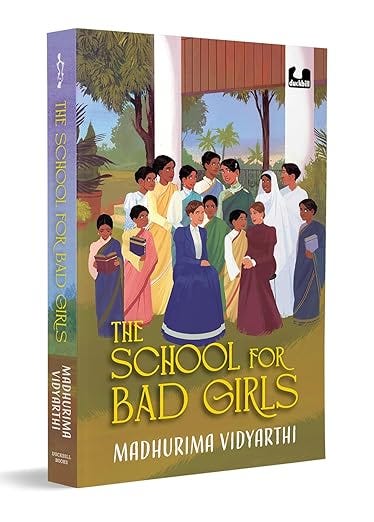The School for Bad Girls by Madhurima Vidyarthi
My take on the book:
1876 Calcutta — Hindu Mahila Bidyalaya an exclusive boarding school for girls where young girls of all ages and castes studied together, has been started by Monomohan Ghosh, lovingly called Dadamoni by Kadambini Ganguly; Dadamoni is her Pishima’s Son and is a barrister who returned back from England. The school is run by an English lady Miss Annette Akroyd.
When eleven-year-old Kumudini is thrashed badly and thrown out of her in-law’s house, she is found and rescued by Dwarakanath Gangopadhyay, who took her to his home. Bidhumukhi, Dwarakanath’s daughter nurses Kumud back to good health. Dwarakanth, referred to as Panditmoshai worked as everything at the school when it first started in 1873 with just five or six girls — from headmaster to gatekeeper, from teaching every subject except English.
When the school had to be shut down few years later, Panditmoshai started a new school in mid 1876 — Banga Mahila Bidyalaya. The new school was supported by two mistresses — Miss Mary Jennings and Miss Fiona Anderson. But soon the school faces crunch of funds; will Pandimoshai be able to sustain the school and will Kadambini be able to fulfill her dream of becoming a doctor forms rest of the story.
This is the true-life story of Kadambini Bose, first lady doctor of India. The story begins when Kadambini moved to Calcutta to study in the Hindu Mahila Bidyalaya, later moved to Banga Mahila Bidyalaya which is later merged with Bethune High School. She further studied at Bethune college, completing her graduate degree and later medicine from Calcutta medical college. All through her studies, Kadambini was the first girl to appear for scholarship exams or entrance exams, in most ways first lady student at many colleges and courses.
The story also touches on the societal practices during that period as once Sati has been abolished, young widows of less than ten years of age were considered as a burden to their families and lived without any respect. The story in parallel narrates the life of Kumud starting from when she was thrown mercilessly onto the streets by her in-laws to following Kadambini’s footsteps to excelling in studies.
The story highlights men like Panditmoshai who fought their entire life for empowerment of girls even at the risk of being ostracized from their community. While Kadambini herself leads this fight, Panditmoshai was her guide and mentor at every step. The author also narrates about the English men and women who equally supported such causes, striking balance with all those who opposed girls’ education, essentially highlighting how nation, gender or caste were not the drivers rather an individual’s sensibilities and commitment.
The biggest drawback of such a wonderful story is the slow pace. While the books starts well establishing all the main characters and their back stories, midway the story drags at places. The story again picks pace in the final pages and even feels rushed at places towards the climax. While it is understandable that the author had to squeeze more than ten years of events into the story, I would have liked more balance in pace between the first and second halves.
While women are still fighting today for equal rights, after more than hundred and fifty years since this story, it is important for the current generation to know how girls first got entry into colleges and higher education. Kadambini’s struggle at every step of education paved way for the future generations and I highly recommend this book to be read by people of all ages.
My rating:
4/5.
Learn more about Book Review — The School for Bad Girls by Madhurima Vidyarthi
